Rapid MetroRail Gurgaon
From Wikipedia, the free encyclopedia







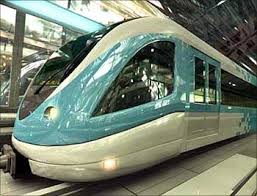
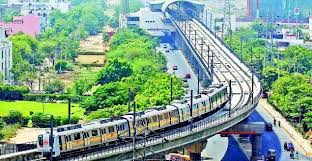
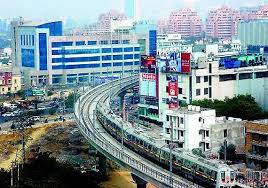
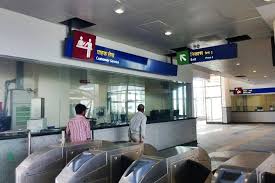
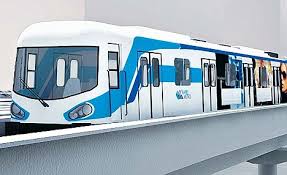
| Rapid MetroRail Gurgaon Limited (RMGL) रैपिड मेट्रो रेल गुड़गांव | ||
|---|---|---|
 | ||
| Background | ||
| Owner | Rapid MetroRail Gurgaon Ltd. (RMGL) | |
| Locale | Gurgaon, Haryana, India | |
| Transit type | Metro | |
| Number of lines | 1 | |
| Number of stations | 6 | |
| Daily ridership | 24,000 (per hour – projected) | |
| Headquarters | Ambience Corporate Towers, Ambience Island, NH 8, Gurgaon | |
| Website | www.rapidmetrogurgaon.com | |
| Operation | ||
| Began operation | 14 November 2013 | |
| Number of vehicles | 5 | |
| Train length | 3 coaches | |
| Headway | 4 minutes | |
| Technical | ||
| System length | 5.1 km[1] | |
| No. of tracks |
2 (1.2 km)
[2]1 (3.7 km) | |
| Track gauge | 1,435 mm (standard gauge)[2] | |
| Electrification | 750 V, DC via third rail[3] | |
| Average speed | 35 km/h (22 mph) | |
| Top speed | 80 km/h (50 mph) | |
| ||
Rapid MetroRail Gurgaon Limited (Hindi: रैपिड मेट्रो रेल गुड़गांव, Raipiḍ Mēţrō Rēl Guḍ.agāṃv) is a metro system in the Indian city of Gurgaon, Haryana, linked with theDelhi Metro system's Yellow Line. Built and operated by Rapid MetroRail Gurgaon Limited (RMGL), the system is India's first fully privately financed metro.[4] It was built at a cost of nearly  1100 crore (US$170 million) and construction was completed in 30 months. Originally planned to open in 2012, the first phase of the system opened on 14 November 2013. [5]
1100 crore (US$170 million) and construction was completed in 30 months. Originally planned to open in 2012, the first phase of the system opened on 14 November 2013. [5]
The project was initially conceived as a collaborative venture between real estate developer DLF and Infrastructure Leasing & Financial Services, or IL&FS. But DLF, facing financial problems, pulled out and IL&FS became the sole owner. It is only privately-funded public metro anywhere in the world. The venture thus does not have any investment by the central government, Haryana or any other public sector undertaking. Rapid Metro did not even get the 20 acres of land which it needed for the project at any concessional rate from the state.[6]
Contents
[hide]History[edit]
The line was originally tendered by the Haryana Urban Development Authority (HUDA) in 2007 as a point-to-point 3.2 km link between Sikanderpur and National Highway 8, but DLF wanted to expand it to provide connectivity to its Cyber City.[4][7] A new tender was issued in July 2008,[8] with the DLF-ILFS consortium emerging as the only bidder.[9] Rapid Metro is the first fully privately financed metro system in India.[10] The project is being implemented under the PPP mode. The entire cost of the project will be borne by the private party and the Haryana Government will provide right of way on lease hold basis. Under this model, the project cost will be borne by the private party and it will also maintain and operate the metro at its own cost.[11] While HUDA initially objected to a private company making profit from public transport, an agreement was eventually reached for the consortium to pay HUDA  7.65 billion(US$117.0 million) over 35 years in "connectivity charges" as well as 5–10% of advertising and property development revenue.[2]
7.65 billion(US$117.0 million) over 35 years in "connectivity charges" as well as 5–10% of advertising and property development revenue.[2]
The contract for the  9 billion (US$137.7 million) project was awarded in July 2009, with completion scheduled in 30 months' time.[2] The foundation stone was laid on 11 August 2009.[12] The line will be built and operated by Rapid MetroRail Gurgaon Limited (RMGL), a consortium of real estate developer DLF and Infrastructure Leasing & Financial Services(IL&FS). DLF owns many properties near the stations while IL&FS is the majority stake holder in the JV.[4] On 21 April 2010, Siemens announced that it had been awarded a turnkey contract to build the metro line, including five 3-car metro trains.[13] The project cost
9 billion (US$137.7 million) project was awarded in July 2009, with completion scheduled in 30 months' time.[2] The foundation stone was laid on 11 August 2009.[12] The line will be built and operated by Rapid MetroRail Gurgaon Limited (RMGL), a consortium of real estate developer DLF and Infrastructure Leasing & Financial Services(IL&FS). DLF owns many properties near the stations while IL&FS is the majority stake holder in the JV.[4] On 21 April 2010, Siemens announced that it had been awarded a turnkey contract to build the metro line, including five 3-car metro trains.[13] The project cost  10.88 billion (US$166.5 million) as at Oct 2012.[14] ILFS has 74% equity and DLF has the remaining 26%.
10.88 billion (US$166.5 million) as at Oct 2012.[14] ILFS has 74% equity and DLF has the remaining 26%.
Phase II[edit]
On 28 September 2008, Haryana's Cabinet approved award of the second phase of the project to a consortium of IL&FS Transportation Networks Ltd and its subsidiary IL&FS Rail Ltd. The southward extension will be 6.5 km long and will extend from Sikanderpur to sector-56 in Gurgaon. There will be 6 stations on the extension and it will take 18 minutes to travel the entire route. Land for the project and right of way will be provided by HUDA.[15] The estimated cost of the project is 2100 crore (US$320 million) and will be executed under design, build, finance, operate and transfer (DBFOT) basis. It is expected to be completed by July 2015.[16][17] On 2 October 2012, Chief Minister Bhupinder Singh Hooda inaugurated the two-kilometre trial run of the metro. He also laid the foundation stone for Phase II of the metro project.[18] The first phase of the metro was tested between Phase 2 and Phase 3 stations.[19]
2100 crore (US$320 million) and will be executed under design, build, finance, operate and transfer (DBFOT) basis. It is expected to be completed by July 2015.[16][17] On 2 October 2012, Chief Minister Bhupinder Singh Hooda inaugurated the two-kilometre trial run of the metro. He also laid the foundation stone for Phase II of the metro project.[18] The first phase of the metro was tested between Phase 2 and Phase 3 stations.[19]
Route[edit]
Phase I[edit]
Rapid Metro covers a distance of 5.1 km. The section between Sikanderpur and Phase 2 is double-tracked, while the remaining stations are served with a single-track loop.[2] Platforms are 75m in length.[20]
Sikanderpur station offers an interchange with Delhi Metro via a 90m x 9m walkway.[21] A depot is located between Micromax Moulsari Avenue and Phase 3 stations.[22]
| Stations | ||||
|---|---|---|---|---|
| # | Station Name | Opening | Connections | Layout |
| 1 | Sikanderpur | Delhi Metro Yellow Line | Elevated | |
| 2 | Phase 2 | 2013[14][23] | None | |
| 3 | Vodafone Belvedere Towers | 2013[14][23] | None | |
| 4 | IndusInd Bank Cyber City | 2013[14][23] | None | |
| 5 | Micromax Moulsari Avenue | 2013[14][23] | None | |
| 6 | Phase 3 | 2013[14][23] | None | |
Phase II[edit]
Phase II will add seven kilometres of double track stretching south of Sikanderpur station along Golf Course Road, with 6 new stations. The construction work of Phase II will be completed by the end of 2015.[24][25]
| Stations | ||||
|---|---|---|---|---|
| # | Station Name | Opening | Connections | Layout |
| 1 | Phase 1 | End 2015[24] | None | |
| 2 | Sushant Lok | None | ||
| 3 | Sec. 42 Crossing | None | ||
| 4 | Sector 54-53 | None | ||
| 5 | AIT Chowk | None | ||
| 6 | Sector 55–56 | None | ||
Infrastructure[edit]
Rolling stock[edit]
On 21 April 2010, Siemens was awarded a turnkey contract to build the metro line, including five 3-car metro trains.[13] Siemens sub-contracted CSR Zhuzhou Electric Locomotive Works to build the 5 aluminium-bodied air-conditioned trains.[3] Each train with 3 coaches costs  300 million (US$4.6 million) and is silver and blue in colour.[26] The total length of a 3 coach train is 59.94m. The coaches are 2.8m wide, have roof-mounted air conditioning and have 4 doors on each side of each coach.[27]141
300 million (US$4.6 million) and is silver and blue in colour.[26] The total length of a 3 coach train is 59.94m. The coaches are 2.8m wide, have roof-mounted air conditioning and have 4 doors on each side of each coach.[27]141
Operations[edit]
Capacity and frequency[edit]
Trains will run from 06:05am – 12:20am.[28] Three-coach trains will operate at 4 minute intervals,[4] with a capacity of 800 approximately passengers per train.[29] The metro is designed to carry 24,000 passengers per hour.[1]
Speed[edit]
The trains will have a maximum speed of 80 km/h, but will operate at an average speed of 30 km/h.[4]
Fares[edit]
The metro will have a flat rate of  12 for the entire line.[30] Delhi Metro commuters do not have to purchase a separate token to travel by the Rapid Metro. They can use their Delhi Metro token or smart card.[31] The automatic fare collection system is supplied by Thales Group.[32]
12 for the entire line.[30] Delhi Metro commuters do not have to purchase a separate token to travel by the Rapid Metro. They can use their Delhi Metro token or smart card.[31] The automatic fare collection system is supplied by Thales Group.[32]
Security[edit]
Security in the Rapid Metro is being handled by Private Agencies, however there would be a dedicated Police Station at Sikanderpur Interchange Station. There would also be Women's Help Desk at every Station, while a Toll Free Helpline +91-124-2800028 for all passengers would be operational for 24 hours. CCTV Cameras would be used to monitor trains and stations.[citation needed]
Safety[edit]
For Passengers' Safety, there would be Emergency Stop Plungers at every Platform, while the Blue Light Station Feature would enable them to contact Control Room. A Press to Talk Button inside coaches would enable commuters to talk directly to the Driver.[citation needed]
Expansion plans[edit]
There are proposals for a North Extension to Udyog Vihar to and an interchange with Maruti Udyog metro station of IGI-iffco Chowk airport express line in Gurgaon. This line would benefit both old and new Gurgaon.[33]
The fare collection system of Rapid Metro (Gurgaon) has been integrated with the fare collection system of Delhi Metro for the convenience of the travelling public.
The fare value of using Rapid Metro i.e Rs 12 can be added in the Tokens purchased from any station of the Delhi Metro and there is no need to purchase any extra token by Delhi Metro commuters for traveling in the Rapid Metro.
Similarly, Rapid Metro Commuters can purchase tokens for traveling in the Delhi Metro system from any station of the Rapid Metro. The smart card users can travel seamlessly with their existing smart cards between both the systems as the DMRC smart card is valid on the rapid metro system also.
The Delhi Metro will integrate with the Delhi Metro at the Sikanderpur Metro Station of Delhi Metro and a flyway/ramp of 90 metres will link the two systems where Public announcement systems and security check points have been installed.
The official website of Delhi Metro www.delhimetrorail.com will also provide a link to the Rapid Metro’s website www.rapidmetrogurgaon.com
Delhi Metro has extended full support to Rapid Metro which is a private public partnership project between HUDA and IL&FS Rail Ltd. covering a distance of 5.1 kms with stations at Sikanderpur, Phase 2, Vodafone Belvedere Towers, Induslnd Bank Cyber City, Micromax Moulsari Avenue and Phase 3 .
Integrated Fare Collection system of Delhi Metro with Rapid Metro for seamless travel
The fare value of using Rapid Metro i.e Rs 12 can be added in the Tokens purchased from any station of the Delhi Metro and there is no need to purchase any extra token by Delhi Metro commuters for traveling in the Rapid Metro.
Similarly, Rapid Metro Commuters can purchase tokens for traveling in the Delhi Metro system from any station of the Rapid Metro. The smart card users can travel seamlessly with their existing smart cards between both the systems as the DMRC smart card is valid on the rapid metro system also.
The Delhi Metro will integrate with the Delhi Metro at the Sikanderpur Metro Station of Delhi Metro and a flyway/ramp of 90 metres will link the two systems where Public announcement systems and security check points have been installed.
The official website of Delhi Metro www.delhimetrorail.com will also provide a link to the Rapid Metro’s website www.rapidmetrogurgaon.com
Delhi Metro has extended full support to Rapid Metro which is a private public partnership project between HUDA and IL&FS Rail Ltd. covering a distance of 5.1 kms with stations at Sikanderpur, Phase 2, Vodafone Belvedere Towers, Induslnd Bank Cyber City, Micromax Moulsari Avenue and Phase 3 .

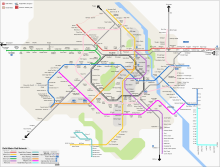
No comments:
Post a Comment